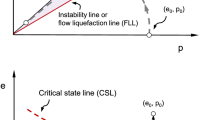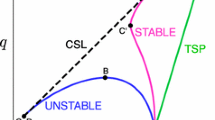Abstract
This study describes a general liquefaction flow instability criterion for elastoplastic soils based on the concept of loss of uniqueness. We apply the criterion to the general case of axisymmetric loading and invoke the concepts of effective stresses and loss of controllability to arrive at a general criterion for the onset of liquefaction flow. The criterion is used in conjunction with an elastoplastic model for sands to generate numerical simulations. The numerical results are compared with experimental evidence to give the following insights into predicting liquefaction. (1) The onset of liquefaction flow is a state of instability occurring under both monotonic and cyclic tests, and coincides with loss of controllability. (2) The criterion proposed herein clearly and naturally differentiates between liquefaction flow (instability) and cyclic mobility. (3) Flow liquefaction not only depends on the potential of the material to generate positive excess pore pressures, but more importantly, it also depends on the current state of the material, which is rarely predicted by phenomenology.










Similar content being viewed by others
Abbreviations
- A 0 :
-
Material constant in Dafalias Manzari model
- A d :
-
Positive scaling function of dilatancy
- c h :
-
Material constant in Dafalias Manzari model
- d 2 W :
-
Second-order work per unit volume
- e :
-
Current void ratio
- e c :
-
Void ratio on critical state line
- e 0 :
-
Initial void ratio
- e c0 :
-
Critical state line material constant
- F :
-
Yield surface
- G :
-
Shear modulus
- G 0 :
-
Elastic shear modulus
- H :
-
Hardening modulus
- H L :
-
Critical hardening modulus
- h :
-
Positive state variable in Dafalias Manzari model
- h 0 :
-
Material constant in Dafalias Manzari model
- K :
-
Bulk modulus
- M :
-
Critical stress ratio
- m :
-
Material constant in Dafalias Manzari model
- M b :
-
Bounding stress ratio
- M d :
-
Dilatancy stress ratio
- n b :
-
Material constant in Dafalias Manzari model
- n d :
-
Material constant in Dafalias Manzari model
- η in :
-
Initial value of η at initiation of a new loading process
- p :
-
Volumetric stress
- \( \dot{p} \) :
-
Volumetric stress rate
- P at :
-
Atmospheric pressure
- Q :
-
Plastic potential
- q :
-
Deviatoric stress
- \( \dot{q} \) :
-
Deviatoric stress rate
- z :
-
Fabric dilatancy factor
- z max :
-
Material constant in Dafalias Manzari model
- α :
-
Back stress ratio
- \( \dot{\alpha } \) :
-
Evolution law for back stress
- β :
-
Dilatancy
- \( \dot{\boldsymbol{\epsilon}} \) :
-
Strain vector increment
- \( \dot{\epsilon}_{\text{a}} \) :
-
Axial strain rate
- \( \dot{\epsilon}_{\text{r}} \) :
-
Radial strain rate
- \( \dot{\epsilon }_{\text{s}} \) :
-
Total deviatoric strain rate
- \( \dot{\epsilon}_{\text{s}}^{\text{e}} \) :
-
Elastic deviatoric strain rate
- \( \dot{\epsilon}_{\text{s}}^{\text{p}} \) :
-
Plastic deviatoric strain rate
- \( \dot{\epsilon}_{\text{v}} \) :
-
Total volumetric strain rate
- \( \dot{\epsilon}_{\text{v}}^{\text{e}} \) :
-
Elastic volumetric strain rate
- \( \dot{\epsilon}_{\text{v}}^{\text{p}} \) :
-
Plastic volumetric strain rate
- η :
-
Stress ratio
- v :
-
Poisson’s ratio
- ψ:
-
State parameter
- λ c :
-
Critical state line material constant
- σ a :
-
Axial stress
- σ r :
-
Radial stress
- \( \dot{\sigma }_{\text{a}} \) :
-
Axial stress rate
- \( \dot{\sigma }_{\text{r}} \) :
-
Radial stress rate
- ξ:
-
Critical state line material constant
References
Alarcón-Guzmán A, Leonards A, Chameau L (1988) Undrained monotonic and cyclic strength of sands. J Geotech Eng 114(10):1089–1108
Andrade JE (2009) A predictive framework for liquefaction instability. Géotechnique 59(8):673–682
Borja RI (2002) Bifurcation of elastoplastic solids to shear band mode at finite strains. Comput Methods Appl Mech Eng 191(46):5287–5314
Borja RI (2006) Condition for liquefaction instability in fluid-saturated granular soils. Acta Geotech 1(4):211–224
Been K, Jefferies MG (1985) A state parameter for sands. Géotechnique 35:99–112
Castro G (1969). Liquefaction of sands, Harvard Soil Mechanics Series, No.81, Pierce Hall
Castro G (1987). On the behaviour of soils during earthquake liquefaction. Technical report, Geotechnical engineers Inc., Winchester, MA. 01890. USA
Dafalias YF, Manzari MT (2004) Simple plasticity sand model accounting for fabric change effects. J Eng Mech 130(6):622–633
Darve F (1996) Liquefaction phenomenon of granular materials and constitutive instability. Eng Comput 13(7):5–28
Darve F, Laouafa F (2000) Instabilities in granular materials and application to landslides. Mech Cohesive-Frictional Mater 5(8):627–652
Gajo A (2004) The influence of system compliance on collapse of triaxial sand samples. Can Geotech J 41:257–273
Hill R (1958) A general theory of uniqueness and stability in elastic-plastic solids. J Mech Phys Solids 6(3):236–249
Hyde A, Higuchi T, Yasuhara K (2006) Liquefaction, cyclic mobility, and failure of silt. J Geotech Geoenviron Eng 132(6):716–731
Ishihara K, Tatsuoka F, Yasuda S (1975) Undrained deformation and liquefaction of sand under cyclic stress. Soils Found 15(1):29–44
Jeremic B, Cheng Z, Taiebat M, Dafalias Y (2008) Numerical simulation of fully saturated porous material. Int J Numer Anal Meth Eng 24:1636–1660
Kramer SL (1996) Geotechnical earthquake engineering. Prentice Hall International Series, New Jersey
Lade PV (1992) Static instability and liquefaction of loose fine sandy slopes. J Geotech Eng 118:51–71
Lade PV (1994) Instability and liquefaction of granular materials. Comput Geotech 16(2):123–151
Lade PV (1999) Instability of granular materials. In: Lade PV, Yamamuro JA (eds) Physics and mechanics of soil liquefaction. Balkema, Rotterdam, pp 3–16
Li XS, Wang Y (1998) Linear representation of steady-state line for sand. J Geotech Geoenviron Eng 124(12):1215–1217
Manzari MT, Dafalias YF (1997) A critical state two-surface plasticity model for sands. Géotechnique 47(2):255–272
Manzari MT, Prachathananukit R (2001) On integration of a cyclic soil plasticity model. Int J Numer Anal Meth Geomech 25:525–549
Nova R (1994) Controllability of the incremental response of soil specimens subjected to arbitrary loading programmes. J Mech Behav Mater 5:193–201
National Research Council (NRC) (1985) Liquefaction of soils during earthquakes. National Academy Press, Washington DC
Qadimi A, Coop M (2007) The undrained cyclic behaviour of a carbonate sand. Géotechnique 57(9):739–750
Schofield A, Wroth P (1968) Critical state soil mechanics. McGraw-Hill, New York
Seed H (1979). Soil liquefaction and cyclic mobility evaluation for level ground during earthquakes. J Geotech Eng Division 105 (GT2) pp 201–255
Sladen J, D’hollander R, Hight D (1985) The liquefaction of sands, a collapse surface approach. Can Geotech J 22(4):564–578
Taiebat M, Jeremic B, Dafalias Y, Kaynia A, Cheng Z (2010) Propagation of seismic waves through liquefied soils. Soils Dyn Earthquake Eng 30:236–257
Vaid YP, Chern JC (1983) Effect of static shear on resistance to liquefaction. Soils Found 23:47–60
Vaid YP, Chern JC (1985) Cyclic and monotonic undrained response of saturated sand. Advances in the Art of Testing Soils under Cyclic Conditions. ASCE, pp 120–147
Vaid YP, Sivathalayan S (2000) Fundamental factors affecting liquefaction susceptibility of sands. Can Geotech J 37(3):592–606
Verdugo R, Ishihara K (1996) The steady state of sandy soils. Soils Found 33:81–92
Yamamuro J, Covert K (2001) Monotonic and cyclic liquefaction of very loose sands with high silt content. J Geotech Geoenviron Eng 127(4):314–324
Yilmaz Y, Mollamahmutoglu M (2009) Characterization of liquefaction susceptibility of sands by means of extreme void ratios and/or void ratio range. J Geotech Geoenviron Eng 135(12):1986–1990
Acknowledgments
AMR acknowledges the financial support given to this work by Pontificia Universidad Javeriana by grant number 004705 'Numerical and experimental research of diffuse instability in granular matter.' Support for JEA’s work was partially provided by NSF grant number CMMI-1060087. This support is gratefully acknowledged. The authors thank Ivan Vlahinic and Utkarsh Mital from Caltech for proofreading this manuscript.
Author information
Authors and Affiliations
Corresponding author
Rights and permissions
About this article
Cite this article
Andrade, J.E., Ramos, A.M. & Lizcano, A. Criterion for flow liquefaction instability. Acta Geotech. 8, 525–535 (2013). https://doi.org/10.1007/s11440-013-0223-x
Received:
Accepted:
Published:
Issue Date:
DOI: https://doi.org/10.1007/s11440-013-0223-x




